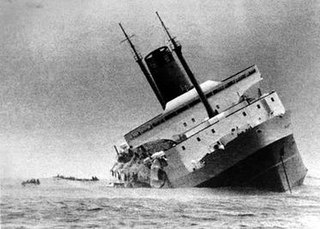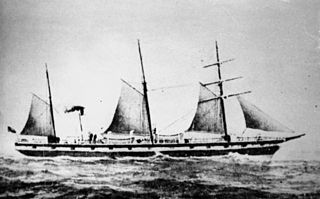
The PS Lady Elgin was a wooden-hulled sidewheel steamship that sank in Lake Michigan off the fledgling town of Port Clinton, Illinois, whose geography is now divided between Highland Park and Highwood, Illinois, after she was rammed in a gale by the schooner Augusta in the early hours of September 8, 1860. The passenger manifest was lost with the collision, but the sinking of Lady Elgin resulted in the loss of about 300 lives in what was called "one of the greatest marine horrors on record". Four years after the disaster, a new rule required sailing vessels to carry running lights. The Lady Elgin disaster remains the greatest loss of life on open water in the history of the Great Lakes.

TEV Wahine was a twin-screw, turbo-electric, roll-on/roll-off ferry. Ordered in 1964, the vessel was built by the Fairfield Shipbuilding and Engineering Company, in Govan, Glasgow, Scotland for the Union Steam Ship Company's Wellington-Lyttelton Steamer Express Service in New Zealand. The ship's name, Wahine, is a word for 'woman' in some Polynesian languages, including Māori.

Lake freighters, or lakers, are bulk carrier vessels that ply the Great Lakes of North America. These vessels are traditionally called boats, although classified as ships.

SS Princess Sophia was a steel-built passenger liner in the coastal service fleet of the Canadian Pacific Railway (CPR). Along with SS Princess Adelaide, SS Princess Alice, and SS Princess Mary, Princess Sophia was one of four similar ships built for CPR during 1910-1911.

SS Milwaukee was a train ferry that served on Lake Michigan. It was launched in 1902 and sank with all hands off Milwaukee on October 22, 1929. Fifty-two men were lost with the vessel.

SS Carl D. Bradley was an American self-unloading Great Lakes freighter that sank in a Lake Michigan storm on November 18, 1958. Of the 35 crew members, 33 died in the sinking. Twenty-three were from the port town of Rogers City, Michigan, United States. Her sinking was likely caused by structural failure from the brittle steel used in her construction as well as extensive use through her 31 year career.

SS Valencia was an iron-hulled passenger steamer built for the Red D Line for service between Venezuela and New York City. She was built in 1882 by William Cramp and Sons, one year after the construction of her sister ship Caracas. She was a 1,598-ton vessel, 252 feet (77 m) in length. In 1897, Valencia was deliberately attacked by the Spanish cruiser Reina Mercedes off Guantanamo Bay, Cuba. The next year, she became a coastal passenger liner on the U.S. West Coast and served periodically in the Spanish–American War as a troopship to the Philippines. Valencia was wrecked off Cape Beale, which is near Clo-oose, on the west coast of Vancouver Island, British Columbia, on 22 January 1906. As her sinking killed 100 people, some classify the wreck of Valencia as the worst maritime disaster in the "Graveyard of the Pacific", a famously treacherous area off the southwest coast of Vancouver Island.

A whaleback was a type of cargo steamship of unusual design, with a hull that continuously curved above the waterline from vertical to horizontal. When fully loaded, only the rounded portion of the hull could be seen above the waterline. With sides curved in towards the ends, it had a spoon bow and a very convex upper deck. It was formerly used on the Great Lakes of Canada and the United States, notably for carrying grain or ore. The sole surviving ship of the "whaleback" design is the SS Meteor, which is docked in Superior, Wisconsin as a museum ship.

The Duncan Dunbar was a clipper constructed for Duncan Dunbar & Company in 1857. It was shipwrecked at the Rocas Atoll off the coast of Brazil on 7 October 1865 on the way to Sydney, Australia.

SS Princess was a steamboat that operated on Lake Winnipeg in Canada from 1881 until 1906. The vessel was built in Winnipeg, Manitoba by the Jarvis & Burridge shipyard, and it was regarded as the pride of Lake Winnipeg and as the finest lake steamer west from the Great Lakes and east from the Rocky Mountains. The vessel has a total of 40 spacious passenger cabins, and outwardly it resembled many of the Mississippi River paddle steamers. The vessel had a top speed of approximately 25 knots.

The SS Gothenburg was a steamship that operated along the British and then later the Australian and New Zealand coastlines. In February 1875, Gothenburg left Darwin, Australia and while en route to Adelaide it encountered a cyclone-strength storm off the north Queensland coast. The ship was wrecked on the Great Barrier Reef north-west of Holbourne Island on 24 February 1875. Survivors in one of the lifeboats were rescued two days later by Leichhardt, while the occupants of two other lifeboats that managed to reach Holbourne Island were rescued several days later. Twenty-two men survived, while between 98 and 112 others died, including a number of high-profile civil servants and dignitaries.

Manchester Liners was a cargo and passenger shipping company founded in 1898, based in Manchester, England. The line pioneered the regular passage of ocean-going vessels along the Manchester Ship Canal. Its main sphere of operation was the transatlantic shipping trade, but the company also operated services to the Mediterranean. All of the line's vessels were registered in the Port of Manchester, and many were lost to enemy action during the First and Second World Wars.

The SS Superior City was considered a pioneer vessel at her launching in 1898. She was the largest vessel ever built on freshwater at that time. She sailed the Great Lakes for twenty-two years until she sank after a collision in 1920 with the steamer Willis L. King in Whitefish Bay of Lake Superior that resulted in the loss of 29 lives. Controversy was immediate over the collision. It was subsequently ruled that the captains of both ships failed to follow the “rules-of-the-road”. Controversy started again in 1988 when the Great Lakes Shipwreck Historical Society produced a video called "Graveyard of the Great Lakes" that included extensive footage of the skeletons of the Superior City crew. The controversy continued as late as 1996 over artifacts removed from her wreck. She is now a protected shipwreck in the Whitefish Point Underwater Preserve.

Henry Ramey Upcher was the second private lifeboat to be stationed in the English town of Sheringham in the county of Norfolk. She was launched on 4 September 1894 and stayed on station for 41 years until she was slowly retired from duty and by 1935 had ceased rescue work completely. The lifeboat is now on permanent display in her own museum housed in her converted original boat shed.

SS Isaac M. Scott was an American Great Lakes freighter that sank during the Great Lakes Storm of 1913 in Lake Huron, 6 to 7 miles northeast of Thunder Bay Island, while she was traveling from Cleveland, Ohio, United States to Milwaukee, Wisconsin, United States with a cargo of coal.

The Phoenix was a steamship that burned on Lake Michigan on 21 November 1847, with the loss of at least 190 but perhaps as many as 250 lives. The loss of life made this disaster, in terms of loss of life from the sinking of a single vessel, the fourth-worst tragedy in the history of the Great Lakes.

The SS Pewabic was a package freighter that served ports on the Upper Great Lakes. She was launched in October 1863, fitted out in the spring of 1864, and was in active service until she sank off Thunder Bay Island in Lake Huron on August 9, 1865, due to collision with her sister vessel. There was significant loss of life, with a number variously estimated at 100 or 125 passengers and crew of the stricken vessel going down with the ship. If the higher number is accepted, the loss of life made this disaster, in terms of loss of life from the sinking of a single vessel, the seventh-worst tragedy in the history of the Great Lakes, and the worst ever on Lake Huron. The sunken hull of the package freighter is a feature of the present-day Thunder Bay National Marine Sanctuary.

The SS Benjamin Noble was a lake freighter that operated on the Great Lakes. Built in 1909 by the Detroit Shipbuilding Company, she was 239 feet (73 m) in length and had a beam of 40 feet (12 m). She was built as a "canaller," a vessel designed for use in what were then the dimensions of the Welland Canal, but was converted by her owners for services in the open Great Lakes. Heavily laden and top-heavy with a cargo of railroad rails, she sank in a Lake Superior storm near Knife River, Minnesota, in April 1914 with the loss of all hands.

Walk-in-the-Water was a sidewheel steamboat that played a pioneering role in steamboat navigation on the Great Lakes. She was the first such craft to run on Lake Erie, Lake Huron and Lake Michigan. Launched in 1818, she transported people and supplies to sites and points of interest around the Great Lakes, before being grounded and wrecked in a gale force storm in Buffalo's bay in 1821. According to some sources, Walk-in-the-Water's name originated from an Indian's impression of a steamboat moving ("walking") on the water with no sails.

SS John Mitchell was a steel-hulled, American lake freighter in service between 1907 and 1911. She was built in 1906 by the Great Lakes Engineering Works in St. Clair, Michigan, for the Cornell Steamship Company of Chicago, Illinois, which was managed by C.W. Elphicke. She entered service in 1907, and had a sister ship named William B. Davock. Throughout her career, John Mitchell carried iron ore and coal. On October 4, 1908, she ran aground at Indiana Harbor, Indiana, while loaded with iron ore.




















